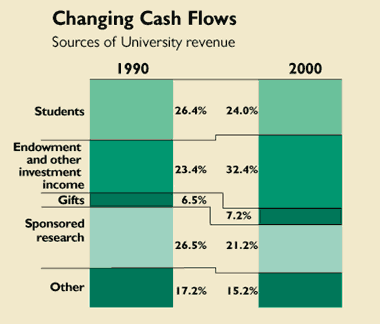Propelled by a surge in funds from the endowment, and to a lesser extent by a wave of gifts from the final phase of the University Campaign, Harvard concluded its fiscal year ended June 30, 2000, with a $120-million operating surplus on an operating budget of $1.9 billion. In their introductory letter to the annual Financial Report to the Board of Overseers of Harvard College, vice president for finance Elizabeth C. Huidekoper and treasurer D. Ronald Daniel characterize the result as "the largest operating surplus in [Harvard's] history." (The report also holds interest as the first financial statement consolidating the Harvard and Radcliffe books; in addition, an accounting change pertaining to real estate produces a restatement of fiscal year 1999, turning the previously reported annual surplus into a deficit.)
Some surplus could have been predicted. The Corporation authorized an extraordinary boost in funds distributed from the endowment for operations effective in fiscal year 2000 (see "The Payoff," January-February 1999, page 62). And indeed, endowment income distributed for operations increased more than 29 percent, from $430 million to $556 million.

At the same time, gifts for current use rose 22 percent, to more than $144 million, and income on centrally administered working-capital funds distributed for University operations rose by almost half, to $88 million. Even with the other major sources of revenue--tuition and student fees, and sponsored-research support (collectively totaling $914 million in the year)--growing by a more modest 4.7 percent, the swelling investment and gift income lifted Harvard revenues overall by 14 percent, or a quarter-billion dollars, to $2.023 billion.
So much for income. Reported expenses rose by just $65 million--less than 4 percent--to $1.902 billion. Adjusting for the change in the way Harvard accounts for the lives and depreciation of its buildings, which caused an unusual bulge in such expenses for fiscal year 1999, expenses climbed about 8 percent.
Salaries, wages, and employee benefits (about half of University outlays) rose 7 percent, fueled by modest compensation increases and the addition of more than 700 new employees; the report points to added positions in sponsored-research programs, new research centers, information technology, executive education, publishing, and, modestly, the faculty ranks. Scholarships and associated student aid--accounted for as a reduction in tuition and fees received--increased nearly 12 percent, to $123 million. Spending on physical plant rose by $90 million, to $250 million in fiscal year 2000, a level expected to be sustained for several years.
Analyzing the operating surplus, Huidekoper notes that $69 million is restricted funds designated for specific purposes: professorships authorized but not yet filled, building projects in the pipeline, and other priorities expected to be completed beyond the confines of any given year. Unrestricted surpluses--$51 million last year--will help the University satisfy its "increasing obligation to support restricted activities with unrestricted resources": providing new professors with office and research space and staff support, for instance, or updating information technology. "[T]he fact that restricted funds have represented a significant part of the real income growth over the past few years poses a problem for Harvard," she and Daniel write. With restricted funds accounting for three-quarters of net assets, growth in departments, academic centers, and support places "add- ed pressure on our unrestricted resources."
In financial terms, endowment and investment income accounts for close to one-third of University revenue now (compared to less than one-quarter in 1990), outstripping the contribution of tuition and student fees--the ultimate source of unrestricted funds. For certain schools, the effect is even more startling: the Faculty of Arts and Sciences received 39 percent of its revenue from endowment income in fiscal year 2000, the Divinity School 56 percent.
In physical terms, beyond those 700-plus new employees, for instance, Harvard routinely has several hundred unfilled positions, implying further demand at a time of sharp constraint on office and laboratory space, classrooms, and housing. Apart from stopgap solutions, says Huidekoper, "We need to build strategic-investment capacity" that will enable the University acting as a whole, for example, to bank the land it has purchased in Allston for future expansion by the separate schools.
Funding that capacity may be forthcoming, in part, from a further boost in the endowment payout. In December (after this issue of Harvard Magazine went to the printer), the Corporation was expected to decide the distribution rate for the fiscal year beginning July 1.
For the moment, the pertinent facts are these: from 1992 through 2000, the endowment grew at a compound annual rate of 14.8 percent after inflation--more than twice the rate for the period from 1974 through 2000. And despite the extra funds paid out by the Corporation for the most recent fiscal year, the distribution (relative to market value) of the rapidly appreciating endowment declined to 3.3 percent--well below the long-term target of 4.5 percent to 5 percent. In other words, Harvard for the foreseeable future happily confronts the opportunities and challenges posed by financial surpluses.





